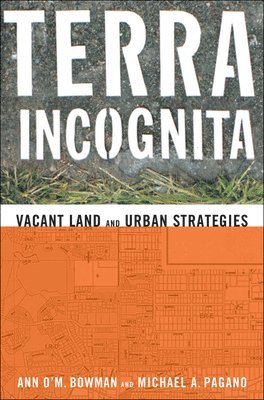
- Format
- Häftad (Paperback / softback)
- Språk
- Engelska
- Antal sidor
- 248
- Utgivningsdatum
- 2004-04-01
- Upplaga
- illustrated ed
- Förlag
- Georgetown University Press
- Medarbetare
- Bowman, Ann OM. (contributions)/Bowman, Ann OM. (contributions)/Pagano, Michael A. (contributions)/Bowman, Ann OM. (contributions)/Pagano, Michael A. (contributions)/Bowman, Ann OM. (contributions)/Pagano, Michael A. (contributions)/Bowman, Ann OM. (contributions)/Pagano, Michael A. (
- Illustratör/Fotograf
- maps Illustrations
- Illustrationer
- Illustrations, maps
- Dimensioner
- 230 x 158 x 14 mm
- Vikt
- Antal komponenter
- 1
- ISBN
- 9781589010079
- 336 g
Terra Incognita
Vacant Land and Urban Strategies
- Skickas från oss inom 5-8 vardagar.
- Fri frakt över 249 kr för privatkunder i Sverige.
Passar bra ihop
De som köpt den här boken har ofta också köpt Who's Afraid of Gender? av Judith Butler (inbunden).
Köp båda 2 för 976 krKundrecensioner
Recensioner i media
Terra Incognita is in many ways the ideal kind of planning book. It's brief; it deals with an important but little-examined aspect of urban life; and it suggests practical ways to improve it. Planning
Övrig information
Ann O'M. Bowman is professor and Hazel Davis and Robert Kennedy Endowed Chair in Government and Public Service, the Bush School of Government and Public Service, Texas A&M University and coauthor of State and Local Government: The Essentials. Michael A. Pagano is director of the graduate program in public administration, College of Urban Planning and Public Affairs at the University of Illinois at Chicago, and coauthor with Ann Bowman of Cityscapes and Capital: The Politics of Urban Development.
Innehållsförteckning
1. The Different Contexts of Vacant Urban LandVacant Land: Negative and PositiveDefining Vacant LandDescribing Vacant Land in U.S. CitiesContext Matters: Vacant Land in Three Metropolitan AreasConclusionNotes2. Cities and Vacant Land: Data and a ModelThe Amount of Vacant Land in U.S. CitiesTerra Incognita: Understanding City ActionsThe Three Imperatives and Vacant LandConclusionNotes 3. City Policymaking: Exploring the Land-Tax DynamicConstraints and Opportunities of General Taxing AuthorityThe Strategic Behavior of Property Tax CitiesThe Strategic Behavior of Sales Tax CitiesThe Strategic Behavior of Income Tax CitiesReflections on the Land-Tax DynamicNotes 4. The Social Value of Vacant Land Mental MapsInfilling as a Social StrategyVacant Land as Open SpaceConclusionNotes 5. The Development Potential of Vacant LandEconomic Development in Metropolitan AreasCapturing LandRecapturing and Recycling Vacant LandConstraining Land UseConclusionNotes6. Strategic Uses of Vacant LandA Spatial Mode of Vacant LandPutting Vacant Land to UseApproaches to Reusing Vacant LandStrategic Thinking and Vacant LandNotes Appendix A: Methodology Appendix B: Demographic, Economic, and Political Data for the Three Site-Visit Metropolitan Areas Appendix C: Data on Vacant Land and Abandoned Structures from the Survey and Data on Population and Area from the Census Bibliography Index
Du kanske gillar
-
The Culture Map
Erin Meyer
HäftadFrågor & svarTransformed
Marty Cagan
Inbunden


